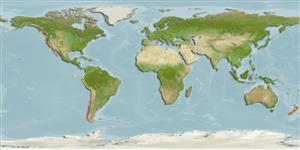Teleostei (teleosts) >
Gobiesociformes (Clingfishes) >
Gobiesocidae (Clingfishes and singleslits) > Gobiesocinae
Etymology: Rimicola: Latin, rima, -ae = crack, cleft + Latin, colere = to live.
More on authors: Meek & Pierson.
Environment: milieu / climate zone / depth range / distribution range
Ecology
Marine; demersal. Subtropical; 55°N -
Eastern Pacific: Queen Charlotte Islands, British Columbia, Canada to Bahia Todos Santos, southern Baja California, Mexico (Ref. 27436).
Size / Weight / Age
Maturity: Lm ? range ? - ? cm
Max length : 7.0 cm TL male/unsexed; (Ref. 2850)
Dorsal spines (total): 0; Dorsal soft rays (total): 6 - 8; Anal spines: 0; Anal soft rays: 6 - 8. First 1 or 2 rays of dorsal fin embedded; caudal roundish, narrow; pelvic fins united anteriorly by wrinkled membrane to form the anterior portion of small adhesive disc which is completed posteriorly by a broad fold of skin from the ventral surface of body, the anterior and posterior segments of the disc separated by lateral clefts (Ref. 6885). Color light olive green to brown; females sometimes sparsely covered with distinct brownish red spots about the size of the pupil of the eye (Ref. 6885).
Clings to strands of kelp (often high in kelp canopy) or eelgrass with its disk; moves to seek food or cover. Rarely found in tide pools.
Life cycle and mating behavior
Maturities | Reproduction | Spawnings | Egg(s) | Fecundities | Larvae
Eschmeyer, W.N., E.S. Herald and H. Hammann, 1983. A field guide to Pacific coast fishes of North America. Boston (MA, USA): Houghton Mifflin Company. xii+336 p. (Ref. 2850)
IUCN Red List Status (Ref. 130435)
Threat to humans
Harmless
Human uses
Tools
Special reports
Download XML
Internet sources
Estimates based on models
Preferred temperature (Ref.
123201): 7.9 - 15.2, mean 10.6 °C (based on 114 cells).
Phylogenetic diversity index (Ref.
82804): PD
50 = 0.5312 [Uniqueness, from 0.5 = low to 2.0 = high].
Bayesian length-weight: a=0.00617 (0.00250 - 0.01521), b=3.15 (2.94 - 3.36), in cm total length, based on LWR estimates for this (Sub)family-body shape (Ref.
93245).
Trophic level (Ref.
69278): 3.2 ±0.4 se; based on size and trophs of closest relatives
Resilience (Ref.
120179): Medium, minimum population doubling time 1.4 - 4.4 years (Preliminary K or Fecundity.).
Fishing Vulnerability (Ref.
59153): Low vulnerability (10 of 100).
